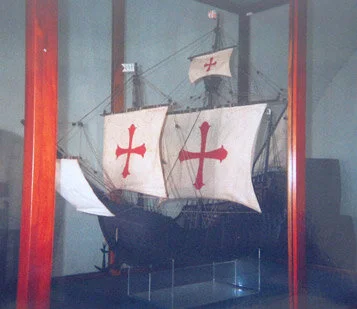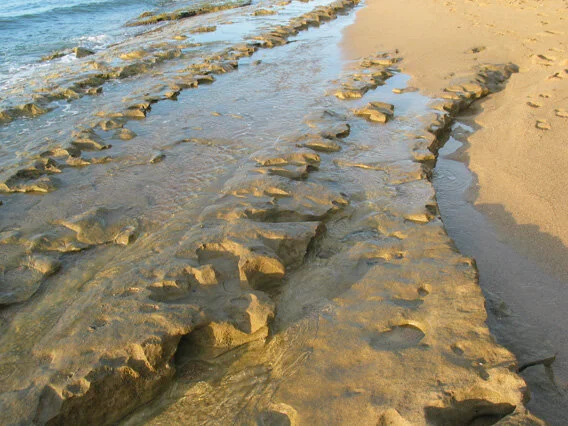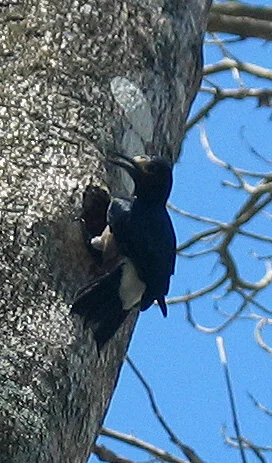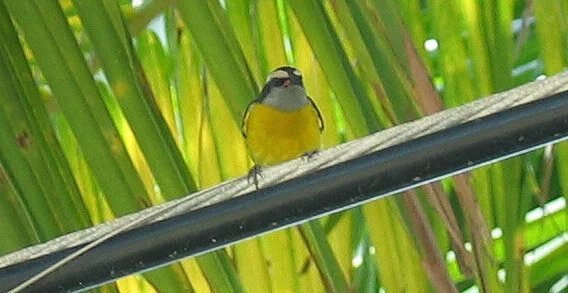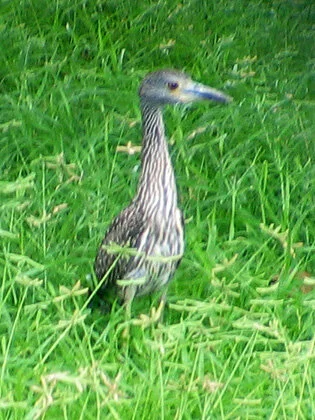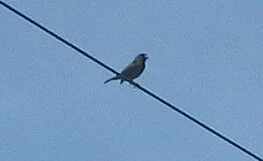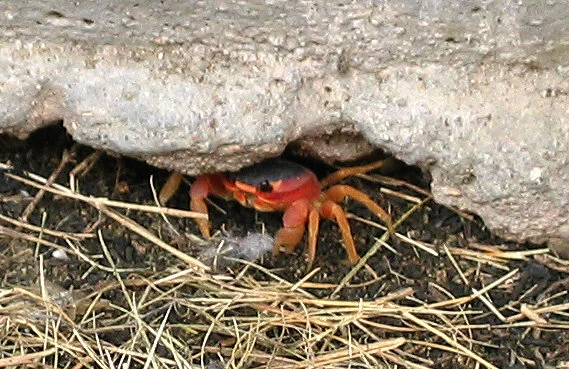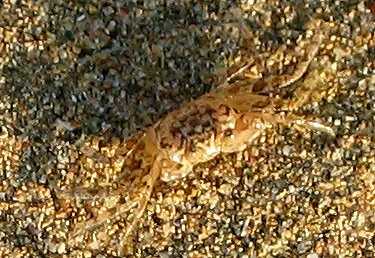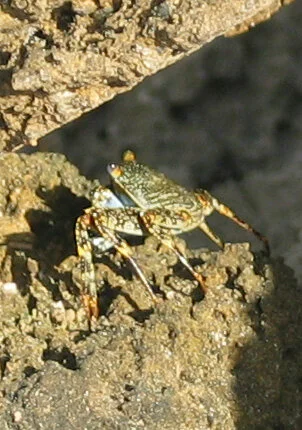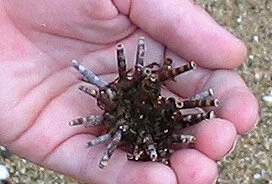Casa Badillo Nature—Some of the Flora and Fauna (and a bit of geology and history) of a tiny portion of western Puerto Rico
Written August 2004 by Barry Langdon-Lassagne
Disclaimer
We have almost no reference texts for the geology, flora and fauna of Puerto Rico (except birds; we have two great bird books). Many of the descriptions are guesses or assumptions by the author. Feel free to send me corrections or additional information.
All photographs are original, taken while on vacation in Puerto Rico August 2004.
Overview
Casa Badillo in the Puntas suburb of Rincón, Puerto Rico is a private guest house with a yard sitting in the shade of coconut palms on Sandy Beach. It is located just downslope from La Cadena Hills which mark the western edge of the tropical-forest-covered Cordillera Central (central hills). Nearby habitats include a small pasture (grassland), an empty lot (grass, weeds and short shrubs), forest (acacia, mango and other trees), rural yards (short grass, cultivated plants), and of course a sand beach (coconut palms, beach vine, beach bean, other vines). Sandy beach runs east-west with the AtlanticOcean to the north. The western edge of the beach is marked by an outcrop of eroded Karstic limestone rocks, which we refer to as "Bikini Rock" (maps label the area as "Punta Gorda"), resting on sandstone. The eastern edge is loosely denoted by tidepools set in smooth sandstone lying at a slight angle on the beach.
Looking East, South and West from Sandy Beach in Rincon, Puerto Rico
The house is two stories, with the bottom floor entirely open air except a bathroom and a utility closet. The top floor has three bedrooms, one & a half baths, a living room, kitchen and wrap-around balcony ("widow's walk"). The windows are screened and have wooden slot-style shutters that can be closed during rainstorms. None of the windows have glass - this gives good air flowthrough and better safety in the event of a hurricane. The top floor is tile throughout.
The weather is mild with temperatures ranging from 72 to 100F in August. The breeze is usually light and almost always from the east or northeast. Rain falls every day nearby but only hits us every 2-3 days, sometimes in spectacular afternoon thunderstorms that last about an hour. The biggest downpour dropped about an inch of rain in one hour. As I write this, hurricane Frances (category 4) is headed west, but is expected to pass north of the island. It may give us some nice big waves.
Our front yard has two Hibiscus bushes, a casuarina bush, several small potted plants and is bordered to the west by date and coconut palms in the neighbor's yard. A telephone pole stands outside the northeast corner of the yard. The front yard supports a pair of Bananaquits that appear to be nesting. On the power pole is the nest of a Gray Kingbird. The Kingbird pair was actively feeding several babies on our first full day here, but after two days the nest was empty, apparently from predation, and the Kingbirds, though still hanging out and feeding in front of our house, no longer approached the nest site. A male and female pair of Antillean Mango hummingbirds feed periodically at the red hibiscus. The female tends to stay approximately five minutes at a time; the male appears less frequently. Common Ground-Doves occasionally forage near our front yard. Zenaida Doves, White-winged Doves and Greater Antillean Grackles sit on the power lines.
The field across the street is the home of several ponies: "Chocolate", "Patches 1", "Patches 2", "Kid Pix" and Coffee" have been named by the children. Cattle Egrets come to sit in the small tree or on top of the ponies occasionally. Anoles hunt along the fences and garden plants along the border of the front yard.
Front yard of Casa Badillo - viewed across the lot where the horses live
Casa Badillo backyard
Our backyard is grass with patches of sand. Red shore crabs live around the edges of the property, which is bordered by a chain-link fence set in a rim of concrete. Along the back are several coconut palms, some quite mature.
To the east is a house with various plants including a broad-leaved Milkweed hosting a single monarch caterpillar. Monarch butterflies have flown through the yard many times. Bright yellow sulphur butterflies have flown through the front and back yards.
Looking south from the balcony - front yard
Looking north from the balcony - back yard
Two doors to the east is Tamboo Bar & Grill, a great restaurant where we have eaten many times. The restaurant is part of a small inn called Beside the Pointe. Across the street, our neighbors run a Pinchos (kebobs) stand on weekends.
History
A model of the Santa Maria - Columbus' flagship on his first western expedition (photo taken at fort San Cristóbal in San Juan)
The Taino lived here and on other Caribbean Islands for many thousands of years before ships from Europe arrived and changed their way of life forever. During his second expedition to the New World, Christopher Columbus briefly landed on Puerto Rico in 1493, somewhere within ten miles of this house.
In 1968, Rincón was made famous in surfer culture by hosting the World Surfing Championship. It continues to be a favorite surfing destination in the winter - when the waves on Sandy Beach are much higher than they are right now.
The B.O.N.U.S nuclear power plant, the first (and only?) in the Caribbean, opened in 1964 and promptly closed in 1970. The plant still stands next to "Domes Beach" (named for the plant) and is still under guard.
The Punta Higüera Lighthouse was originally built in 1882, was periodically destroyed or burned, and eventually rebuilt in 1993 to commemorate the 500th anniversary of Christopher Columbus' landing near here.
Casa Badillo was probably built in the mid 1980s as a private beach residence, and later made into a vacation rental.
Currently, this coast is the arrival point for Hispaniolan refugees, mostly from the Dominican Republic. While we were here, one of their boats made landfall less than a mile from Sandy Beach.
An abandoned boat, likely used by refugees from the Dominican Republic to cross the Mona Channel and land here
Geology
We are fortunate to have a wonderful outcropping of sedimentary rocks at both ends of Sandy Beach. "Bikini Rock" to the west has an incredible array of fossils. To the best of my knowledge, the outcropping is Karst limestone, from the Tertiary period (between 24 and 55 million years ago). By the lighthouse there are outcroppings more obviously Karst (they better match what we saw up at Arecibo Observatory and Rio Camuy Caverns in the Karst district to the northeast).
Satellite photo of the Rincón area. Casa Badillo is on Sandy Beach along the north shore (photo taken at Arecibo Observatory and annotated in Photoshop)
The Geology of the Rincón Area. We are near the boundary between the small Karst limestone outcropping and the Volcanic/Sedimentary Central Hills
Bikini Rock' to the West - Karst limestone
Sandstone tidepools to the East
With all this sedimentary rock around, there are bound to be fossils and sure enough if you climb around 'Bikini Rock' you'll see a variety of fossilized creatures, most especially coral. The sandstone outcropping also has some fossil coral and shells. In between the beach is all sand, but offshore there are more rocks, likely the same as the rock outcropping to the west. Much of the sand of Sandy Beach is probably eroded sandstone.
The Fossils of ‘Bikini Rock’
Flora
There is an amazing variety of plants in our neighborhood. Residents plant all the regular "exotic" tropical species such as hibiscus and banana. The weeds seem to be dominated by relatives of the pea family, with some wild cucumber, milkweed, and morning glory. All along the edge of the beach, for miles, the coconut palm dominates the landscape. Casa Badillo has eleven coconut trees in its small backyard, not counting the ones leaning over from the adjacent properties.
Coconut trees in various stages of growth (on beach)
Beach Vine (Ipomoea pez-caprae - Convolvulaceae, Morning-Glory family)
The Milkweed next door
Red Hibiscus (front yard)
Red Hibiscus
Yellow Hibiscus
Bougainvillaea
Coconut Palm
Date Palm
Grass
Casuarina(?) bush
Casuarina(?) trees
Small fan palm
Philodendron
Papaya
Beach Morning-Glory
Beach Bean, Cannavalia maritima, "Green Three-Leaf" - pea family
Cundeamor, Momordica Charantia, "wild cucumber"
Beach Bean, (Cannavalia maritima) which we were calling "Green Three-Leaf" (on beach)
Yellow Hibiscus and Bougainvillaea in front yard
Cundeamor (Momordica Charantia) Wild Cucumber
Birds
Birding is one of our primary interests, and from the property we have seen many great species, ten of them life birds for us. Part of the diversity comes from Casa Badillo being on the edge of two habitats: ocean/beach and forest, with a bit of grassland/pasture across the street. My favorite sighting of the trip was the pair of Puerto Rican Woodpeckers that woke us up one morning as they foraged on one of the coconut palms in the backyard. We've only seen them on the property once, but almost all the coconuts that fall in the yard have woodpecker-sized holes in them.
The endemic Puerto Rican Woodpecker (picture taken of wild bird at Mayagüez Zoo)
Bananaquit - our reliable front-yard resident
There are at least two Yellow-crowned Night-Herons, an adult and an immature, that regularly hunt the crabs in our yard. The Caribbean Martins, Gray Flycatchers and Greater Antillean Grackles all seem to compete for roosting space in the trees by the intermittent creek that opens to the sea about 3/4 mile to the east of us. A pair of Kestrels hunt in from the poles in the front yard, and the Gray Kingbirds regularly catch large insects from the wires in front.
Kestrel (Hispaniola race) - on pole beside "Beside the Pointe"
Gray Kingbird (front yard)
The following birds were seen on the property, or from the property, during our stay at Casa Badillo August 12 - September 2, 2004:
Brown Booby (immature flies past over ocean)
Magnificent Frigatebird (flies over ocean and beach)
Brown Pelican (flies over ocean)
Laughing Gull (over ocean)
Royal Tern (over ocean)
Sandwich Tern (over ocean)
Yellow-crowned Night-Heron (hunts in backyard and on beach)
Cattle Egret (empty lot across street)
Spotted Sandpiper (on beach, and on road!)
Red-tailed Hawk (flies over front)
American Kestrel (poles in front)
Junglefowl (empty lot across street)
*Puerto Rican Woodpecker (on coconut palm in backyard)
*Scaly-naped Pigeon (flies past front yard)
Common Ground-Dove (front yard, neighbor's yard)
White-winged Dove (wires)
Zenaida Dove (wires)
Rock Pigeon (wires)
*Antillean Mango (hibiscus in front yard)
Gray Kingbird (nest in power pole in front, chicks lost to predation)
*Pearly-eyed Thrasher (palms in backyard)
Northern Mockingbird (wires)
*Cave Swallow (over house)
Cliff Swallow(?)
Barn Swallow (over house)
Northern Rough-winged Swallow(?)
*Caribbean Martin (overhead)
*Bananaquit (nest in bougainvillaea or yellow hibiscus)
*Greater Antillean Grackle (wires, palm trees in front)
*Black-faced Grassquit (front yard, wires)
*Yellow-eyed Grassquit (down the street, by The Landing)
House Sparrow (front yard)
Nutmeg Mannikin (front yard, wires)
* = new life bird for us
Spotted Sandpiper (photo taken in hippo exhibit at Mayagüez Zoo)
Yellow-crowned Night-Heron juvenile - next door to the east
Greater Antillean Grackle (wires in front)
Yellow-crowned Night-Heron - adult on construction fence to west
Black-faced Grassquit (wires by The Landing)
Brown Booby (picture taken at El Faro)
Mammals
Not much to say on the mammal front. We have our resident rats. The bats come every night to eat the bugs; one of the bats has about a 14" wingspan.
Bat species
feral dog
feral cat
mouse or vole (taken by a Kestrel)
rat
In Winter, Humpback Whales breed offshore.
Reptiles and Amphibians
The most common reptile seen is the Anole, which can be found in our yard pretty much any time. The most common reptile or amphibian heard is the coqui, a small frog that calls every night, or after rain, or during rain, or at other random times. The nearby skinks grow so large that I almost think they could be monitor lizards.
Anole (front yard)
Anole (all over yard, especially on fences and trees)
Gecko (house geckos)
Coqui (adult heard only, eggs and polliwogs seen in local puddles)
Skink with turquoise dots along side of belly (up the street in deeper forest)
Big Skink
Insects
There are butterflies and other insects everywhere here. We really wish we had a Caribbean insect guide. Luckily, many of the species are familiar, or similar enough to familiar ones that we can give some indication what they are.
Silver-spotted Skipper (front yard)
True Bug with horns on its back
Monarch Butterfly - the yard next door to the east contains a broad-leaved milkweed plant with at least one Monarch caterpillar. Monarchs fly over daily
large black butterfly with yellow marks near each wingtip
Red Admiral
American Painted Lady
large Yellow Sulphur
white cabbage butterfly
large flying Cockroach
click beetle
mosquito
shield bug (milkweed beetle?)
cicada
grasshopper
red biting ants (ow)
tiny pale yellow grease ants
argentinian? ants
silver-spotted skipper
assassin bug
lightning bug (or firefly if you like)
small black beetle
green bug (true bug)
carpenter bees
gnats
termites
june beetle (golden)
true bug with horns on back
Firefly
Buckeye (picture taken near the B.O.N.U.S. decommissioned Nuclear Power Plant down the road)
Cicada (on back patio)
Other Invertebrates
Hermit Crab (on beach below house)
Shore Crab (red)
Sea Cucumber
Chiton
Dark purple sea urchin
Ghost Crab
Hermit Crab
Zebra Crab (striped crab on rocks)
Orb Web Spider
Red Shore Crab (under patio)
Ghost Crab (on beach)
Zebra Crab ("Bikini Rock")
Orb Web Spider (picture taken at Steps Beach)
Sea Life
An unusual sea urchin that washed ashore
Sea Biscuit
There is so much nature just under the surface of the water that there's no way we can do it justice here. About 10 yards from the shore there is a line of rocks in about 6 feet of water that house seaweeds, sea urchins, sea cucumbers, sea biscuits, chiton, fish, small sharks and other creatures. Beyond that the sea floor is sandy for at least 50 yards out and slowly deepens to about 12 feet. There is probably live coral further out, or to the west of Sandy Beach. Many different types of shells wash ashore including scallop, periwinkle, cones, cowrie and snails.
Bibliography
Birds of Puerto Rico and the Virgin Islands, revised edition - Herbert A. Raffaele, Princeton University Press, 1989.
Birds of the West Indies - Herbert Raffaele, James Wiley, Orlando Garrido, Allan Keith, Janis Raffaele, Princeton Field Guides, Princeton University Press, 2003.
Flowers of Puerto Rico and the Exotics, Edwin Miner Solá, 1998.
Natural Puerto Rico, Alfonso Silva Lee, Pangaea, 1998.
Geologic map based on one courtesy of Puerto Rico's Eco-Cultural Foundation, from a picture taken at Rio Camuy Caverns
Satellite Map based on a photograph of a much more comprehensive satellite photo taken in the Arecibo Observatory's museum




